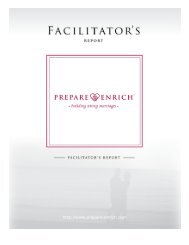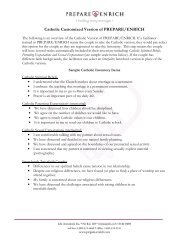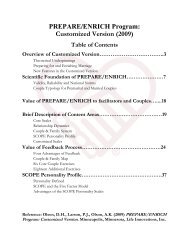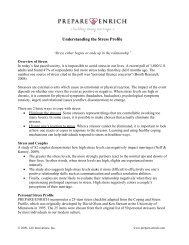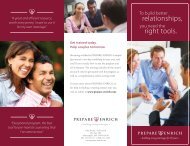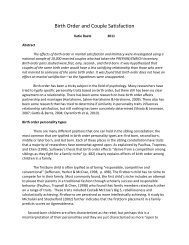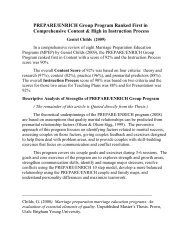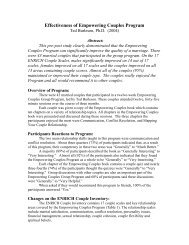Top Stressors for Couples (click here) - Prepare/Enrich
Top Stressors for Couples (click here) - Prepare/Enrich
Top Stressors for Couples (click here) - Prepare/Enrich
Create successful ePaper yourself
Turn your PDF publications into a flip-book with our unique Google optimized e-Paper software.
<strong>Top</strong> <strong>Stressors</strong> <strong>for</strong> <strong>Couples</strong>“Stress either begins or ends up in the relationship”Overview of StressIn today’s fast paced society, it is impossible to avoid stress in our lives. A recent poll of 1,000U.S. adults and found 47% of respondents feel more stress today than they did 6 months ago.The number one source of stress cited in the poll was “personal finance concerns” (BoothResearch, 2008).<strong>Stressors</strong> are external events which cause an emotional or physical reaction. The impact of theevent depends on whether one views the event as positive or negative. When stress levels arehigh or chronic, it is common <strong>for</strong> physical symptoms (headaches, backaches), psychologicalsymptoms (anxiety, anger) and relational issues (conflict, disconnection) to emerge.T<strong>here</strong> are 2 basic ways to cope with stress:• Eliminate the stressor. Some stressors represent things that are controllable (working toomany hours). In some cases, it is possible to make choices that actually eliminate thestressor (change jobs).• Change one’s reaction to stress. When a stressor cannot be eliminated, it is important tolook at how one reacts or copes in response to the stressor. Learning and using healthycoping mechanisms can help individuals respond to stress in healthier ways.Stress and <strong>Couples</strong>A recent study of 82 couples demonstrates how high stress levels can negatively impactmarriages (Neff & Karney, 2009).• The greater the stress levels, the more strongly partners react to the normal ups anddowns of life. In other words, when stress levels are high, we experience perceivedslights more intensely.• The study also suggests high stress levels make it more difficult to effectively use one’spositive relationship skills such as communication and conflict resolution abilities.• Finally, couples are more likely to evaluate their relationship negatively when they areexperiencing prolonged exposure to stress. High stress negatively colors a couple’sperceptions of their marriage.Personal Stress ProfileThe new Customized Version of PREPARE/ENRICH incorporates a 25-item stress checklistadapted from the Coping and Stress Profile, which was originally developed by David Olson and
Ken Stewart at the University of Minnesota in 1995. The 25 items were chosen from theiroriginal list of 50 personal stressors faced by most individuals in our modern culture.While taking their inventory, individuals are directed to read through the checklist and indicatehow often each of the 25 items has caused them stress over the past year. The five point responsescale ranges from “Never” to “Very Often”. Based on the responses, a Personal Stress Profile isgenerated and displays each partner’s individual stress level and the top ten stressors <strong>for</strong> eachindividual. An item must be checked as being stressful “Sometimes”, “Often”, or “Very Often”to be included in a top ten list.Customized Version Tailored to Relationship StageA defining feature in the Customized Version of PREPARE/ENRICH involves content beingtailored to fit the stage of the couple, and this approach is used <strong>for</strong> the Personal Stress Profile aswell. T<strong>here</strong> are dating, engaged, and married versions of the stress checklists which areautomatically selected as the couple answers the initial background questions in their inventory.<strong>Top</strong> 5 <strong>Stressors</strong> <strong>for</strong> <strong>Couples</strong>Based on results from the first 20,000 couples to complete the Customized Version, the top 5stressors <strong>for</strong> each relationship stage are listed below. Overall, married couples report higherstress levels than dating or engaged couples.Dating <strong>Couples</strong> Engaged <strong>Couples</strong> Married <strong>Couples</strong>Your job Your job Your spouseFeeling emotionally upset Financial concerns Your jobInadequate income Cost of wedding Feeling emotionally upsetYour partner Lack of exercise Inadequate incomeToo much to do around the home Lack of sleep Too much to do around the homeMarried <strong>Couples</strong> and StressNote the item rated as the number one stressor by married couples is Your spouse. This was thenumber one stressor cited by both the men and the women. Married couples who takePREPARE/ENRICH are often being seen in a counseling situation. It is not uncommon <strong>for</strong>individuals experiencing relational conflict to believe their problems would be solved if theirpartner would only change. Not only do they believe this, they often express it. Experiencedcounselors are used to the finger pointing which often accompanies the initial sessions of maritaltherapy. Un<strong>for</strong>tunately, one partner cannot change the other and this approach leaves individualstotally disempowered in the relationship. In fact, the more one individual focuses on the otherperson’s behavior, the more resentment, anger, and resistance they typically receive in return.
It is much more productive to help these couples work on things that are in their controlincluding the way the speak to one another, the way the resolve conflict, the way each individualchooses to react to their daily stressors and interactions with their spouse.Wedding <strong>Stressors</strong> and Engaged <strong>Couples</strong>Ten of the 25 checklist items <strong>for</strong> engaged couples are specifically associated with weddingplanning and target the stressors couples typically face as they plan their “big day”. Engagedcouples are typically embroiled in the countless details of planning their wedding service andreception. They are also faced with the pressures of a very high price tagIn many ways, planning a wedding provides the first big set of decisions a couple will maketogether and tests their ability to function as a team. From finances to family, andcommunication to conflict, the wedding preparations trigger many of the issues a couple willface throughout their married life providing a symbolic practice field <strong>for</strong> their relationship. Inlooking at the initial data, the Cost of the wedding is the number 3 overall stressor <strong>for</strong> engagedcouples. Two other items from the wedding items also made the top 10; Decisions aboutwedding details was number 7, and Feeling overwhelmed by wedding details was number 10 outof the 25 stressors reported by engaged couples.Skilled PREPARE/ENRICH facilitators often leverage a couple’s wedding stressors and issuesto provide them with relevant feedback and education. Rather than asking the couple to imaginehow finances will be handled in their future marriage, they engage the couple in a discussion ofhow they are making financial decisions right now as they plan their wedding, reception, andhoneymoon.Male/Female DifferencesOn average, the data shows women report slightly higher stress levels than men. Men andwomen also report slightly different sources of stress. Many couples are not aware of how muchstress their partner is feeling, nor are they aware of one another’s sources of their stress. The datasuggests men in all stages are stressed about jobs, finances, and their partner. While the womenhighlight some of those stressors, they also report they have Too much to do around the homeand are often Feeling overweight. Notice the item, Feeling emotionally upset, makes the top 5 <strong>for</strong>both men and women in the dating and married relationship stages, but does not make the top 5<strong>for</strong> men and women who are engaged. Below is a summary of the top 5 stressors <strong>for</strong> men andwomen broken down by relationship stage.Dating Men <strong>Top</strong> 5 <strong>Stressors</strong>Your jobInadequate incomeYour partnerFeeling emotionally upsetJob securityDating Women <strong>Top</strong> 5 <strong>Stressors</strong>Feeling emotionally upsetYour jobToo much to do around the homeFeeling overweightYour partner
Engaged Men <strong>Top</strong> 5 <strong>Stressors</strong>Your jobFinancial concernsFiancé stressed out by wedding planningLack of exerciseLack of sleepMarried Men <strong>Top</strong> 5 <strong>Stressors</strong>Your spouseYour jobInadequate incomeFeeling emotionally upsetJob securityEngaged Women <strong>Top</strong> 5 <strong>Stressors</strong>Financial concernsYour jobCost of weddingLack of exerciseDecisions about wedding detailsMarried Women <strong>Top</strong> 5 <strong>Stressors</strong>Your spouseFeeling emotionally upsetYour jobToo much to do around the homeFeeling overweightPREPARE/ENRICH Couple ExercisesThe new Couple’s Workbook includes three exercises devoted specifically to the topic of stress.• The first, Identifying Most Critical Issues, is a core exercise designed to help couples takea logical approach to prioritizing the issues they face and consider what they can actuallychange as they work together.• The Balancing Your Priorities exercise functions almost like a time budget, allowingcouples to explore how balanced they are between work, personal, marriage and familydemands. It also helps them set goals <strong>for</strong> making adjustments to their daily time demands.• Finally, the Wedding Stress exercise presents important insight in the <strong>for</strong>m of five helpfulstrategies <strong>for</strong> dealing with the issues that naturally arise when planning a wedding.5 Tips <strong>for</strong> Using the Personal Stress Profile1. Build understanding and empathy: Help couples identify and discuss the source oftheir stress, making sure they each understand what their partner is feeling andexperiencing.2. Prioritize stressors to tackle first: Use the Identifying Most Critical Issues exercisefrom the workbook to help couples discern which stressors they have control over andcan actually change if they work together and support one another. If their partner is alarge source of stress in their lives, help them understand they only have control overthemselves and their own reactions to one another. They cannot make the other personchange.
3. Consider the relationship stage: While engaged couples may be distracted by weddingdetails, their current stressors can present a good context to build insight and skills intohow the rest of their relationship will function, even after their wedding. Meet themw<strong>here</strong> they are at instead of trying to get them to imagine future scenarios.4. Use the stress discussion to transition to other skills building: Keep in mind that thebest ways to cope with stress often involve other core relationship skills such as healthycommunication, conflict resolution, flexibility, and closeness. An effective approach <strong>for</strong>dealing with the issues identified in the Personal Stress Profile will often include teachingcouples to use these other important skills, and the stress profile functions as a goodtransition tool <strong>for</strong> teaching core relationship skills.5. Teach couples to take a Time-out when needed: As the research suggests, high stresslevels make it more difficult <strong>for</strong> couples to effectively use their relationship skills.Teaching couples the How to Take a Time-Out exercise may also be important <strong>for</strong>helping them slow down, gain perspective, and actually use the skills they’ve beentaught.References:Neff, L.A., and Karney, B.R., (2009). Stress and reactivity to daily relationship experiences:How stress hinders adaptive processes in marriage. Journal of Personality and SocialPsychology, 97 (3), 435-450.© 2009, Life Innovations, Inc.




